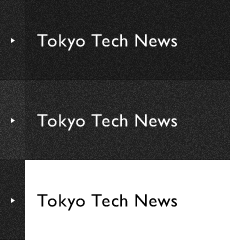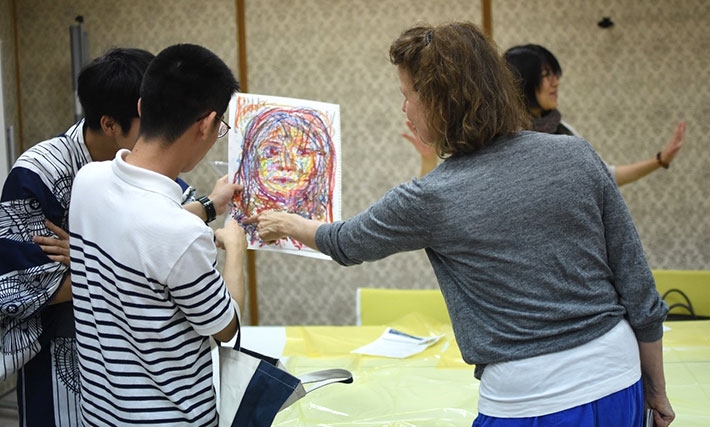
Artist Zuse Meyer (right) with students
Tokyo Tech students were in for a treat on May 6 and June 13 when artist Zuse Meyer visited Ookayama Campus to facilitate two Art with an Artist seminars. The objective was to gain knowledge and insight into the world art — specifically the styles of Vincent van Gogh and Pablo Picasso — under the guidance of an active professional artist, and to discover one's own expressive abilities through a number of sketching and drawing activities.
Meyer, a graduate of the Berlin University of the Arts and based in both Tokyo and Berlin, provided lectures in both English and Japanese, and critiqued each student's work individually on both days. Twenty-three students joined the van Gogh seminar, while nineteen students were present to learn about Picasso.
May 9: Vincent van Gogh
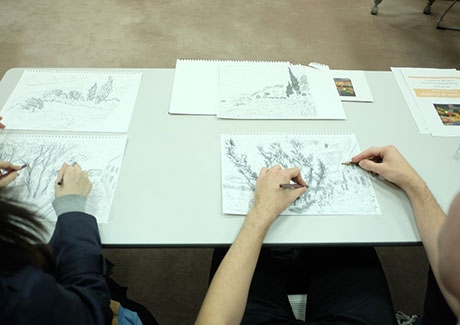
Sketching with both hands
Meyer began the first session with an introduction of van Gogh's short yet legendary life. She then showed works from different periods of his career and photos of the area where he spent a large part of his time. Meyer's talk also included interpretations of the source of van Gogh's power and ability to focus, particularly in the last two years of his life. After this, it was time for participants to create sketches and drawings using their dominant hand, non-dominant hand, and finally both hands, while being inspired by Van Gogh's landscapes and pictures of southern France.
Drawings created with the dominant hand are consciously controlled and tend to be technically superior, but this consciousness is lost in case of the non-dominant hand, giving way to the intrinsic power and energy of the artist. Drawing with both hands requires the use of both the right and left sides of the brain simultaneously. "Art and creation is not about imitating or learning techniques to make products. Rather, it is essential to believe in yourself, view something wholeheartedly, and create new expressions," Meyer explained.
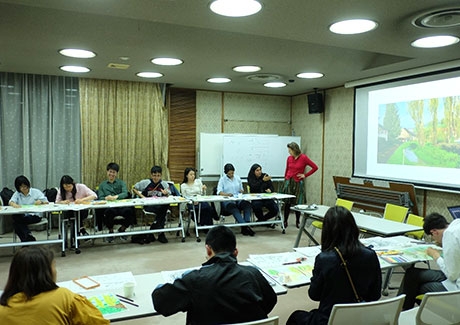
Students recreating scenery of southern France with crayons
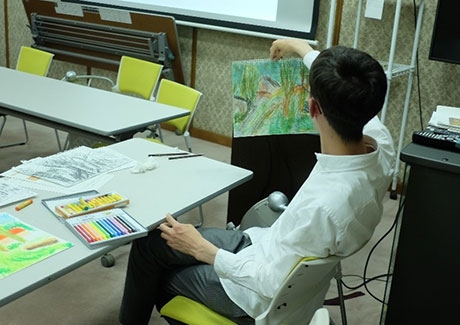
Same model picture, very different results among participants
June 13: Pablo Picasso
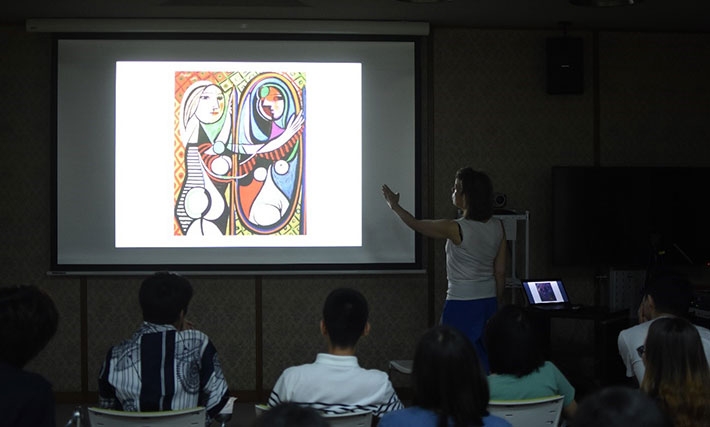
Meyer lecturing on Pablo Picasso
The second session introduced the work of Pablo Picasso through his portraits. Meyer explained that Picasso never stuck with or tried to perfect a certain technique, but instead was constantly changing and striving to create new expressions. After being inspired by Picasso's unique imagination, energy, and freedom, the participants picked up pencils and crayons themselves, diving into the world of portraits and self-portraits.
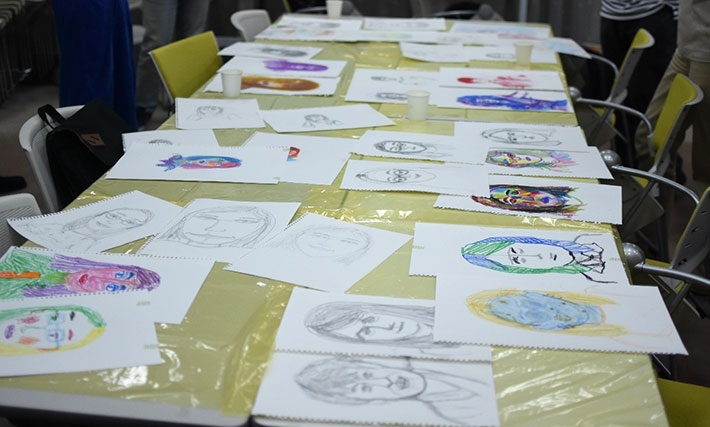
Participants' creations: Portraits with pencils and crayons, pieces created with right hand, left hand, both hands
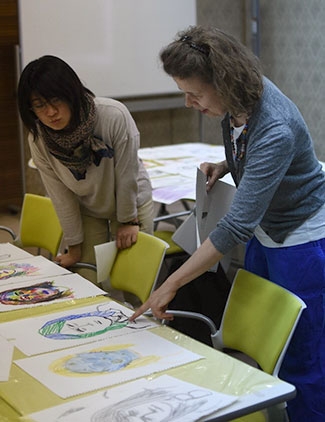
Critique by Meyer (right) of each piece of work
After two hours of drawing time, the room was a different place. None of the participants could believe the unique creations that had emerged. "Art is not like the Olympics. It is fine if everyone's creation is different. Every piece of art has its good sides," Meyer concluded. By viewing each creation as a group and listening to Meyer's critical commentary, the participants were able to realize the rich, individual diversity existing in each piece.
The satisfaction of the participants was evident from the comments left during the post-event surveys.
- I gained a lot of confidence in my own style.
- The flow of things — learning various things first and then actually trying things out myself — was great.
- The seminar involved the continuous use of both hands and my brain, and I learned to use both sides of my brain simultaneously.
- Everyone participated actively throughout, and many beautiful piece of art were born.
- It was fantastic to see the different types of art that emerged despite everyone working on the same task.
- Before the seminar, I was worried that I was poor at drawing. That all changed. Ms. Meyer was extremely friendly, and my perception of art completed transformed.
- The way I view new things expanded, which was great. I really appreciated being critiqued by an actual artist.
- This was a completely new experience for me!
- I discovered new ways of thinking and approaching challenges.
- As time passed my perception changed, which was great fun.
- Bringing out our creativity by doing rather than planning was amazing!
- I am grateful that I was able to express my own creativity thanks to this art seminar.
- Using various methods, the instructor encouraged us to create art freely, which was very pleasant.
- This was an important occasion for me to feel and think about art.
- It was very interesting to see how differently each person expressed himself or herself.
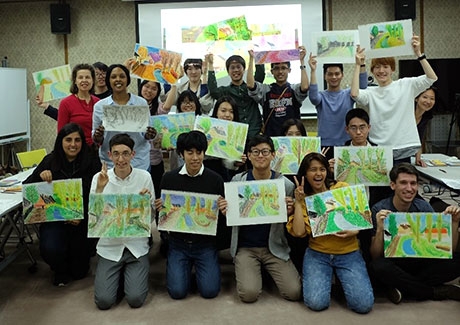
Van Gogh seminar participants
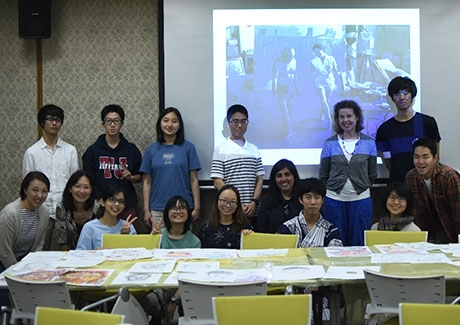
Picasso seminar participants
Allowing the creativity of each individual to shine is an important factor in science and technology research. To ensure that Tokyo Tech students — many of whom will soon become researchers and engineers — have constant opportunities and outlets to express themselves, the Student Support Center will continue to organize extracurricular activities such as the Art with an Artist seminar.
. Any information published on this site will be valid in relation to Science Tokyo.











